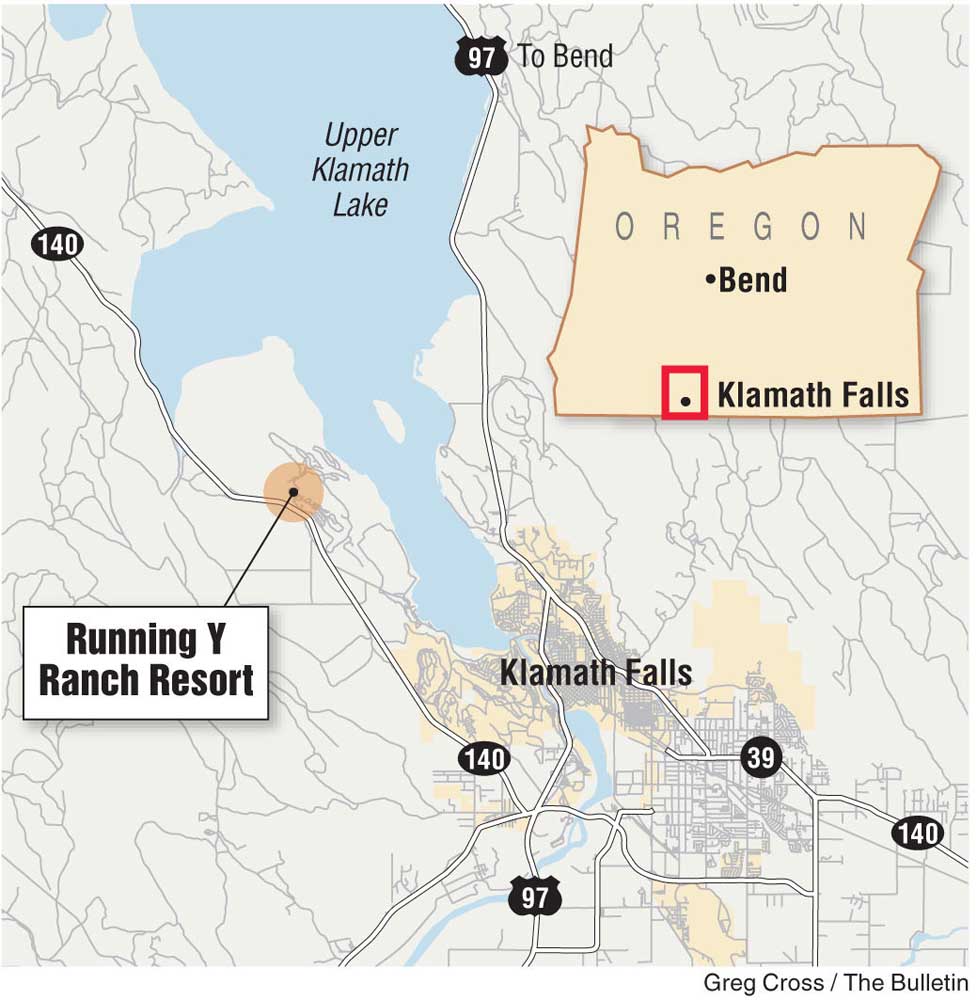Northwest Travel: Zip lines, birding & more near Klamath Falls
Published 12:00 am Sunday, September 18, 2016

- Northwest Travel: Zip lines, birding & more near Klamath Falls
KLAMATH FALLS — A long time ago, in a galaxy far, far away, I competed in a high school ski race on Tomahawk Mountain.
Three runs, served by a single chairlift, comprised Tomahawk Ski Bowl. The total vertical was about 600 feet, from the hill’s 4,800-foot summit to the highway that wraps around Upper Klamath Lake. It wasn’t a big ski area, but it was enough to entertain skiers from Klamath Falls, a half-hour drive away, and to make it a destination for the region’s junior ski racers.
Trending
A combination of economics and diminishing snowfall led Tomahawk’s owners to close the little resort in 1984. Proposals to build a new, grander ski resort on nearby 8,037-foot Pelican Butte ran into environmental roadblocks before running out of steam. In the more than three decades that followed, the recreation area went largely unused and its once-groomed slopes filled with young conifers.
Finally, just over a year ago, the hill found a new purpose. Roe Outfitters, a Klamath Falls-based outfitter that also specializes in kayaking and fishing adventures, opened the region’s first zip line last August. It’s been a resounding success.
Darren Roe, who was raised in Eugene but settled in Southern Oregon after a short spell in corporate banking in Portland, started in the guide business in 1984. But he never imagined that the company he owns with his wife, Jenifer, a Klamath Falls native, would be taking guests down a hillside on high wires until they were made aware of the opportunities on Tomahawk.
Zip and paddle
Roe said he had been looking into zip lining for at least five years — attending international conferences and studying construction methods — when he discovered the opportunity to develop Tomahawk last spring. A contractor completed the installation work at the start of August and Crater Lake ZipLine began serving adventurers mid-month.
The zip line — Oregon’s eighth, but the first east of the Cascade crest — has nine long, fast lines extending from the hilltop, a pair of swinging suspension bridges and a couple of rappels, including a short free-fall at the conclusion of the run. From each platform, views extend across the colorful marshlands of Upper Klamath, the state’s largest lake.
Trending
The three-hour experience, Roe said, has already shown itself to be far more popular than he ever imagined it would be.
Zip lining is the newest but hardly the only recreational pursuit in the Klamath Falls area. Roe Outfitters itself has solo and tandem kayaks, canoes and stand-up paddle boards available for rent. Three separate scenic areas, including the Wood River, which feeds Agency Lake on the north side of Upper Klamath, and Spring Creek, a Williamson River feeder near Collier State Park, have been designated for tours.
Zip liners can also combine two adventures into Roe’s “Skyak” day, which couples a morning on the wires with an afternoon in the serene Malone Springs area in the Upper Klamath National Wildlife Refuge.
Trips through the marsh-lined channels of the Upper Klamath wetlands are far more than physical exercise. They also are exercises in wildlife watching, not only for that of the four-legged variety. In fact, the Klamath Basin is world renowned as a bird-watching destination.
Birding adventures
The Pacific Flyway, a long-distance aerial highway by which migratory birds travel between Alaska and South America, passes directly above the basin. That’s enough to make the half-dozen Klamath Basin National Wildlife Refuges the most visited birding location in all of the American West.
It’s estimated that 75 to 80 percent of all waterfowl on the Pacific Flyway make a stop in the Klamath Basin each spring and especially fall, when peak concentrations can exceed 1 million birds. Federal observers have counted 433 separate resident and migratory avian species in the open water, freshwater marshes and grassy meadows of these refuges — as well as its sage-and-juniper-accented grasslands, evergreen forests and agricultural lands.
My photographer partner, Barb Gonzalez, took several hours one morning last week to explore some of the lakeside marshes and woodlands with birding guides Darrel Samuel and Gerry Hill. They began their exploration at the Running Y Ranch Resort, where a brace of a half-dozen young bucks briefly stole their attention from quail and scrub jays as the deer wandered between the country club-style residences surrounding the resort’s golf course.
Gonzalez later showed me photos of some of the birds they had spotted, either at the Running Y or in the Eagle Ridge and Skillet Handle areas extending into Upper Klamath Lake a few miles farther north. There were multitudes of migratory smaller birds, from white-breasted and pygmy nuthatches to barn swallows and downy woodpeckers by the dozens.
There was waterfowl aplenty. A great egret held fast to a small snake it had snagged in a bog as a white-faced ibis searched for its own protein. A raft of about 30 blue-winged teals scouted the shallow waters. They shared the wetlands with Western grebes, Brandt’s cormorants, avocets in summer plumage, terns, gulls and white pelicans still enjoying Oregon before flying to California’s Central Valley for the winter. Cooper’s hawks and other raptors soared overhead.
Gonzalez said she looks forward to Klamath Falls’ annual Winter Wings Festival, a mid-February event that brings photographers and bird experts together for a variety of field trips, workshops and lectures — at a time when the seasonal populations of snow geese and tundra swans are at their peaks.
The Running Y
My friend didn’t see a ruddy duck on her excursion, but we found one at the Running Y. The Ruddy Duck is the resort’s restaurant, and it’s a fine place to enjoy a meal or two. Its health-conscious “Blue Zones Project” focuses attention on regional sustainability in menu selection, offering a range of vegetarian-friendly meals at all hours of the day.
We didn’t go with the veggies, other than an excellent Caesar salad; but we definitely stayed regional in our meal choices. Those included a halibut Puttanesca sandwich at lunch, and dinners including a pan-roasted duck breast with spinach and mushrooms and an elk sirloin steak with huckleberry gastrique.
Executive chef Matt Renshaw, a Medford native who has been at the Running Y for a year and a half, returned to Oregon after a spell at Wyoming’s Grand Targhee resort, and he seems to have found a home here. And a fine home it is: Open to the main lobby of the Running Y lodge and to a second-story bridge that connects its two wings, the fully licensed restaurant features a large patio with an expansive view across the back nine of the resort’s golf course.
The Running Y was established in 1996 by the Jeld-Wen Corporation. In recent years, however, it has gone through several permutations of ownership. Since its purchase in September 2014 by California-based CLV Properties, the 3,600-acre community has gradually incorporated renovations — especially in the lodge’s 82 guest rooms — that indicate a leap from a rustic appeal to something a bit more elegant.
A sales push to attract groups and conventions with special off-season rates is paying dividends. Large parties are accommodated in a 7,500-square-foot conference center and in vacation homes and townhouses available through the resort. The Sandhill Spa offers a full menu of massage and other treatments (I recommend the deep-tissue massage; Gonzalez liked the reiki rebalancing treatment), while the Running Y Sports Center includes an indoor pool and fitness facility, tennis, basketball and volleyball courts.
Golf with Arnie
I was drawn to play 18 holes on the resort’s Arnold Palmer signature golf course, open since 1998. The beautifully designed course follows marshy bottomlands for four holes, turns back across a tree-lined hillside for five, then retreats past ponds and fairways overpopulated with Canada geese into narrower glades before returning to the clubhouse.
I hooked into the fescue grass on my first drive. Determined to avoid a stream that guarded the right side of the fourth fairway, I put myself in a sand trap that guarded a dogleg. On the par-3 fifth, pitching over a pair of curious rock chucks, I landed my ball perfectly just 2 feet from the pin — then watched helplessly as it rolled off the green into a water hazard.
But the straight-as-an-arrow, sixth hole offered little resistance to a par of four. The deceiving seventh hole had its pin toward the front of a large green that seemed to say, “Ace me!” The intriguing ninth was all downhill back to the clubhouse; a solid drive rolled a long way toward a small green framed by bunkers.
And the back nine — well, at least half of the back nine was all about avoiding noisy geese and their excrement. But that’s a circumstance shared by many golf courses, especially those in birding areas!
Klamath Falls
Klamath Falls was established in 1867 as Linkville, acknowledging its location on the Link River — a mile-long stream connecting Upper and Lower Klamath lakes. Its name was changed in 1893 to Klamath Falls, a series of cascades in the middle of that river. They aren’t much to see today, as irrigation canals and a couple of small hydroelectric plants have funneled most of the water away from the Link River. But with a little imagination, hikers along a short riverside trail can still pick out the falls.
With an urban population of around 42,000, including the city of Klamath Falls (21,000) and adjacent, unincorporated Altamont (19,000), Klamath is regarded as the largest city in southeastern Oregon and the nearest to Crater Lake National Park, a little more than an hour’s drive to the north.
A good reason to visit is to spend time in its two fine museums. The Favell Museum of Western Art and Indian Artifacts, founded in the 1970s, has an outstanding exhibit of Native American objects from the era before white settlement, as well as the largest collection of miniature firearms in the world.
The Klamath County Museum, in a pre-Second World War National Guard armory, focuses on the natural and human history of the region. The county museum also operates the Baldwin Hotel Museum, open summers, and the Fort Klamath Museum, a 19th-century army fort on the route to Crater Lake that has artifacts from the Modoc Indian War of its era.
The art-deco Ross Ragland Theater is a popular stop for touring musicians and thespians as well as the Linkville Players, a community theater group.
— Reporter: janderson@bendbulletin.com








